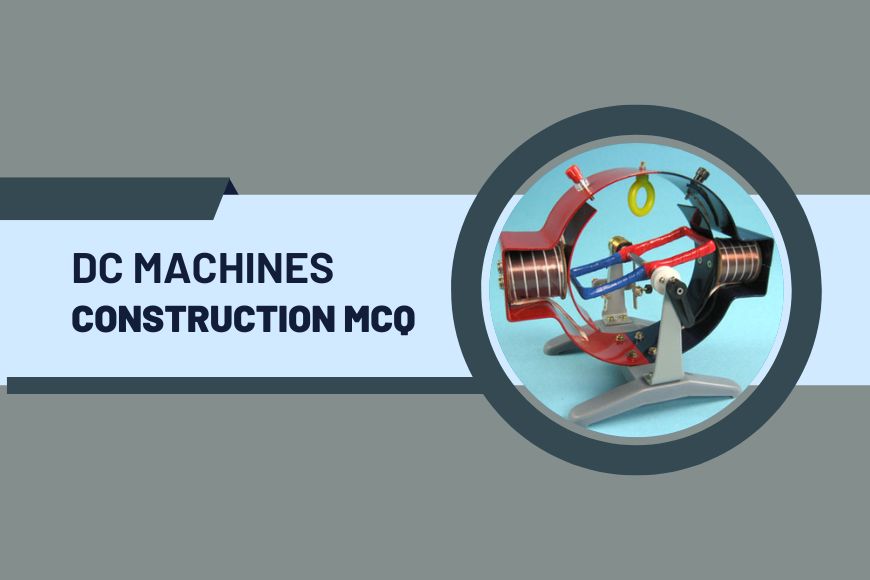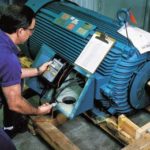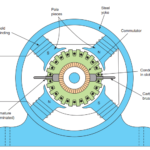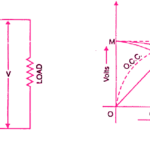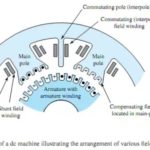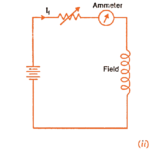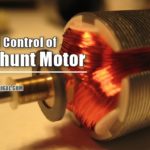This set of DC Machines Construction MCQ focuses on objective questions based on construction of dc generator and dc motor.
DC Machines Construction MCQ Question 1
The commutator segments are connected to the armature conductors by means of
- Copper lugs
- Resistance wires
- Insulation pads
- Brazing
Answer:
? Click here for answer ?
Option 1 – Copper lugs
Detailed Explanation
- A commutator is a mechanical rectifier which converts the alternating voltage generated in the armature winding into direct voltage across the brushes.
- The commutator is made of copper segments insulated from each other by mica sheets and mounted on the shaft of the machine.
- The armature conductors are soldered to the commutator segments in a suitable manner to give rise to the armature winding.
- Depending upon the manners in which the armature conductors are connected to the commutator segments, there are two types of armature winding in a dc. machine vi: (a) lap winding (b) wave winding.
- Great care is taken in building the commutator because any eccentricity will cause the brushes to bounce, producing unacceptable sparking. The sparks may burn the brushes and overheat and carbonise the commutator.
DC Machines Construction MCQ Question 2
Which type of shape is used for carbon brushes in DC machine?
- Triangular
- Square
- Cylindrical
- Semi-circular
Answer
? Click here for answer ?
Option 2 : Square
Detailed Explanation
Carbon brushes in DC machine:
- Brushes are used to collect the current due to the induced emf from the armature coils in a DC generator.
- When a brush is at any particular segment, it shorts out that particular coil and draws current from the rest of the coils,
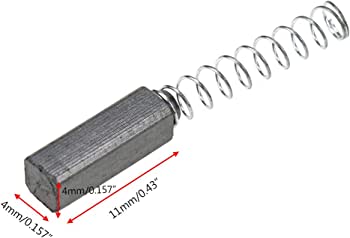
- Brushes are made up of carbon to reduce the wear and tear of the commutator.
- If emf induce in that coil, the huge current will flow.
- To prevent this, brushes are positioned in such a way that the coil being short-circuited has no emf in it to prevent heat loss in the brushes and sparking at commutator segments
- Hence brushes are placed along the magnetic neutral axis.
- Carbon brushes are square shaped
DC Machines Construction MCQ Question 3
Which of the following part is used in construction of DC machine but not in AC machine?
- Armature Winding
- Field winding
- Commutator
- Shaft
Answer
? Click here for answer ?
Option 3 : Commutator
Detailed Explanation
AC (alternating current) machines and DC (direct current) machines are both electrical machines, but they have some constructional differences. Here are some of the main differences between AC and DC machines:
- Commutator and brushes: One of the most obvious differences between AC and DC machines is the presence of a commutator and brushes in DC machines. The commutator is a rotating component in a DC machine that helps to switch the direction of the current in the armature windings. The brushes are stationary components that provide electrical contact with the commutator. AC machines do not have a commutator or brushes, as the current alternates in direction and does not need to be switched.
- Armature winding: The armature winding is the coil of wire that is wound around the rotating component of the machine. In a DC machine, the armature winding is connected to the commutator segments. In an AC machine, the armature winding is connected to slip rings that allow the AC current to be fed into the winding.
- Field winding: The field winding is the coil of wire that produces the magnetic field in the machine. In a DC machine, the field winding is connected in series or parallel with the armature winding. In an AC machine, the field winding is usually located on the stator, which is the stationary part of the machine.
- Voltage regulation: DC machines have a better voltage regulation than AC machines. This is because the output voltage of a DC machine can be easily controlled by adjusting the field current. In an AC machine, the output voltage is affected by factors such as the load and the power factor.
- Efficiency: AC machines are generally more efficient than DC machines. This is because AC machines have less friction and heat loss due to the absence of brushes and commutators. Additionally, AC machines are easier to cool because the heat is generated in the stationary part of the machine.
These are some of the main constructional differences between AC and DC machines.
DC Machines Construction MCQ Question 4
Which of the following is not a function of the magnetic frame in a DC generator?
- It provides low reluctance path for flux.
- It carries the magnetic flux produced by the poles in the DC generator.
- It acts as a protective cover for the whole machine
- It provides mechanical support for the poles in the DC generator.
Answer
? Click here for answer ?
Option 3 : Commutator
Detailed Explanation
The magnetic frame, also known as the yoke, of a DC generator serves several important functions:
- Provides a Path for Magnetic Flux: The yoke is made of magnetic material such as cast iron, and it provides a low reluctance path for the magnetic flux to flow through the poles and the armature. This ensures that the maximum amount of magnetic flux is directed to the armature, which is essential for generating a high voltage output.
- Supports the Poles: The yoke provides a sturdy support structure for the poles of the DC generator. The poles are mounted on the yoke and are held in place by bolts or other fasteners. This ensures that the poles are held securely in place and do not move or vibrate during operation.
- Acts as a Shield: The yoke acts as a shield that helps to contain the magnetic field within the generator. This prevents the magnetic field from interfering with other nearby electrical devices or causing other unwanted effects.
- Dissipates Heat: The yoke is also designed to dissipate heat generated during operation. The yoke provides a large surface area that can dissipate heat through convection and radiation, helping to keep the generator cool and preventing it from overheating.
Overall, the yoke is an important component of a DC generator that plays a critical role in ensuring efficient and reliable operation.
